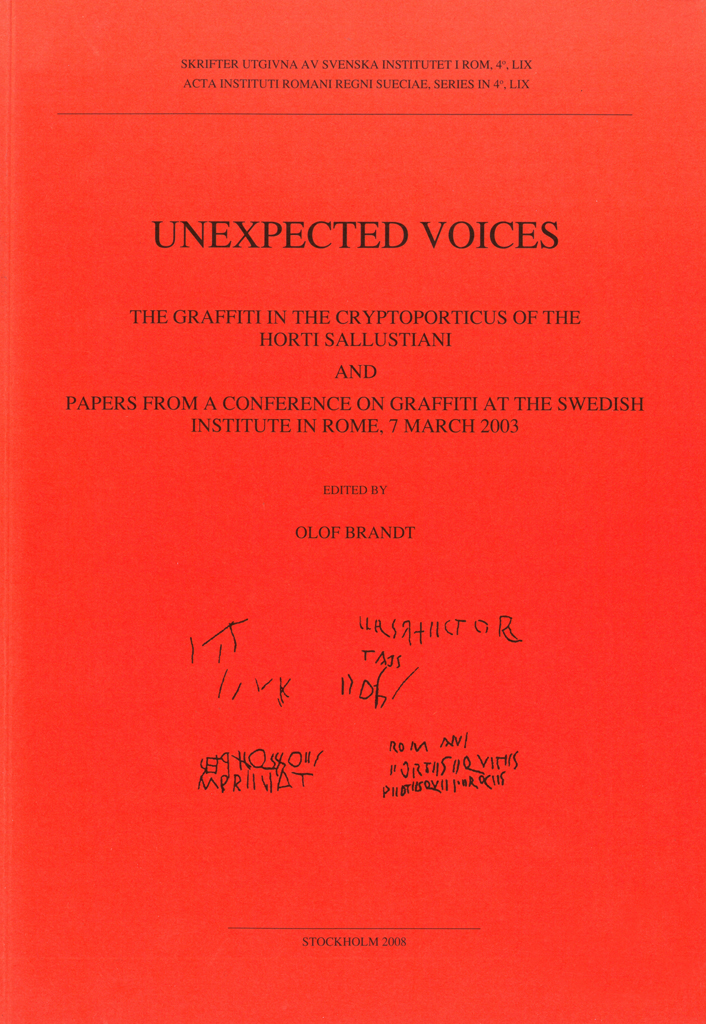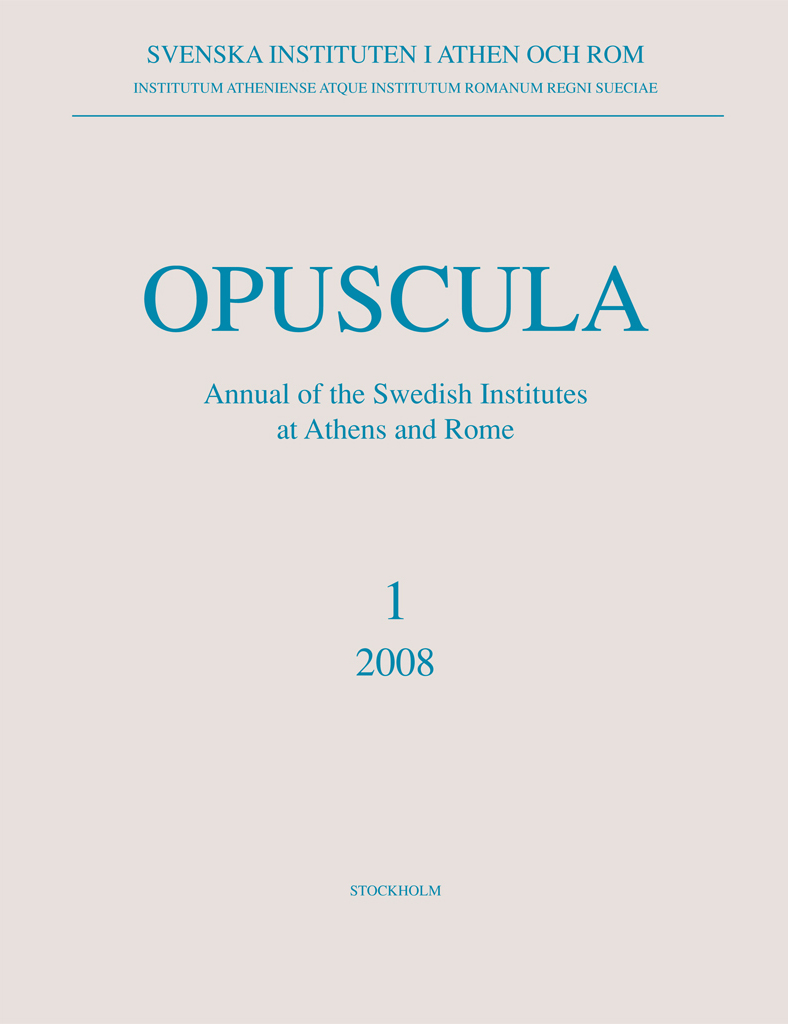Now available for purchase at Amazon.com, Amazon.de, Bokus.com, Adlibris.com. Distributed by Eddy.se AB. Unexpected voices. The graffiti in the cryptoporticus of the Horti Sallustiani and papers from a conference on graffiti at the Swedish Institute in Rome, 7 march 2003 By Olof Brandt (ed.) This volume presents the results of a collaboration between the Swedish Institute in Rome and the Embassy of the United States of America in Rome. The object of the research was a cryptoporticus, part of the ancient Horti Sallustiani, in the area of the American Embassy, and especially the graffiti found on the walls of the cryptoporticus, which were also decorated with paintings. The cryptoporticus, which is dated to the first century AD, was excavated in 1949–1950 and in the 1990s, but the graffiti have never been completely published. In this publication, all the graffiti are discussed and dated. Some belong to Late Antiquity, others were made in the 16th and 17th centuries. The study of these graffiti gives important information about the later fate of the first-century cryptoporticus. Several unpublished fragments of wall-paintings are also presented, and more general historic and archaeological aspects of the cryptoporticus are discussed. Part of the project was the first…
Opuscula 1 (2008) is out of print. Available for free download at Bokorder.se. Used copies might be available at Amazon.com and Amazon.de. Books reviewed in Opuscula 1 (2008) R.S. Merrillees | Hala Sultan Tekke XII. Tomb 24, stone anchors, faunal remains and pottery provenance, edited by Paul Åström & Karin Nys (SIMA 45:12), Sävedalen: Paul Åströms Förlag 2007. 62 pp., ills., tables. ISBN 978-91-7081-228-6. https://doi.org/10.30549/opathrom-01-17 Charlotte Scheffer | Works dealing with questions concerning ancient Greek vases (books reviewed: Approaches to the study of Attic vases, by P. Rouet; The Theseus Painter, by O. Borgers; The late mannierists in Athenian vase-painting, by T. Mannack; Non-Attic Greek vase inscriptions, by R. Wachter; Corpus Vasorum Antiquorum. Ny Carlsberg Glyptotek 1, by T. Fischer-Hansen; Corpus Vasorum Antiquorum. Amsterdam 3, by W.D.J. van de Put; Essays in honor of Dietrich von Bothmer, by A.J. Clarc & J. Gaunt, eds.). https://doi.org/10.30549/opathrom-01-18 Johannes Siapkas | The complexities of Hellenism—a review article (books reviewed: Placing modern Greece, by C. Güthenke; The nation and its ruins, by Y. Hamilakis). https://doi.org/10.30549/opathrom-01-19 Bibliographical information ‘Book reviews’, Opuscula. Annual of the Swedish Institutes at Athens and Rome (OpAthRom) 1, 185–197. Stockholm 2008. ISSN: 2000-0898. ISBN: 978-91-977798-0-7. Softcover, 198 pages.
Opuscula 1 (2008) is out of print. Available for free download at Bokorder.se. Used copies might be available at Amazon.com and Amazon.de. Paul Åström (1929–2008)—The Swedish nestor of archaeology By Peter M. Fischer https://doi.org/10.30549/opathrom-01-14 Paul Åström in memoriam 1929–2008 By Ann-Louise Schallin https://doi.org/10.30549/opathrom-01-15 Tullia Linders (1925–2008) By Gullög Nordquist https://doi.org/10.30549/opathrom-01-16 These contributions are only available in print. Bibliographical information ‘In memoriam’, Opuscula. Annual of the Swedish Institutes at Athens and Rome (OpAthRom) 1, 179–184. Stockholm 2008. ISSN: 2000-0898. ISBN: 978-91-977798-0-7. Softcover, 198 pages.
Opuscula 1 (2008) is out of print. Available for free download at Bokorder.se. Used copies might be available at Amazon.com and Amazon.de. Die Büste eines Afrikaners aus der Sammlung Piranesi in Stockholm By Carmen Marcks Abstract A portrait bust of an African placed among the antiquities in the Royal Museum at Stockholm once belonged to the Roman artist Giovanni Battista Piranesi. It was brought to Sweden at the end of the 18th century at the instance of King Gustav III. The head is a work of the middle or second half of the 16th century. It belongs to a specific, local, Roman form of Mannerist portraits, which have in common a remarkable affinity to antique imperial portrait busts. While the head is an eclectic work combining an idealized countenance—a contemporary peculiarity of portrait art—with antique usages of portrayal, the bust itself seems to be a work that stands directly in the tradition of cinquecentesque Venetian busts. Obviously head and bust were not originally created as an ensemble. This contribution is only available in print. Bibliographical information Carmen Marcks, ‘Die Büste eines Afrikaners aus der Sammlung Piranesi in Stockholm’, Opuscula. Annual of the Swedish Institutes at Athens and Rome (OpAthRom) 1,…
Opuscula 1 (2008) is out of print. Available for free download at Bokorder.se. Used copies might be available at Amazon.com and Amazon.de. I muri trasversali di Santa Croce in Gerusalemme e la sinagoga di Ostia By Olof Brandt Abstract The reasons behind the unusual internal division of the first phase of the church of Santa Croce in Gerusalemme have never been fully explained. This paper proposes an explanation of the phenomenon with the help of a comparison with the Synagogue of Ostia Antica. Bibliographical information Olof Brandt, ‘I muri trasversali di Santa Croce in Gerusalemme e la sinagoga di Ostia’, Opuscula. Annual of the Swedish Institutes at Athens and Rome (OpAthRom) 1, 155–166. Stockholm 2008. ISSN: 2000-0898. ISBN: 978-91-977798-0-7. Softcover, 198 pages. https://doi.org/10.30549/opathrom-01-12
Opuscula 1 (2008) is out of print. Available for free download at Bokorder.se. Used copies might be available at Amazon.com and Amazon.de. Reconsidering the tomb of Aulus Hirtius By Henrik Gerding Abstract Since its discovery, the tomb of Aulus Hirtius in Rome has been regarded as a firmly dated monument and, thus, constituted a widely used fixed point for those tracing the early development of Roman brick architecture. However, several peculiarities regarding the construction of the tomb and its inscriptions strongly indicate that the present dating, which is based on historical sources, may not be correct. In this note it is suggested by the author that the original tomb was destroyed and thoroughly remodelled in the early or mid-Augustan period. Some general implications of this regarding the introduction of brick architecture in Rome are also considered. Bibliographical information Henrik Gerding, ‘Reconsidering the tomb of Aulus Hirtius’, Opuscula. Annual of the Swedish Institutes at Athens and Rome (OpAthRom) 1, 145–154. Stockholm 2008. ISSN: 2000-0898. ISBN: 978-91-977798-0-7. Softcover, 198 pages. https://doi.org/10.30549/opathrom-01-11
Opuscula 1 (2008) is out of print. Available for free download at Bokorder.se. Used copies might be available at Amazon.com and Amazon.de. A forgotten tomb at Hippokome and its neighbours By Paavo Roos Abstract A rock-cut tomb in Hippokome on the Lyco-Carian border was overlooked in an earlier survey and is published here, together with an adjacent blind door and two niches with sockets for stelai beside it, and another tomb and a niche in the vicinity. Bibliographical information Paavo Roos, ‘A forgotten tomb at Hippokome and its neighbours’, Opuscula. Annual of the Swedish Institutes at Athens and Rome (OpAthRom) 1, 137–144. Stockholm 2008. ISSN: 2000-0898. ISBN: 978-91-977798-0-7. Softcover, 198 pages. https://doi.org/10.30549/opathrom-01-10
Opuscula 1 (2008) is out of print. Available for free download at Bokorder.se. Used copies might be available at Amazon.com and Amazon.de. Nuovi dati sul popolamento nella pianura di Tarquinia durante la romanizzazione. Il caso della località “Il Giglio” By Maria Gabriella Scapaticci Abstract During works for a communal athletic-ground at Tarquinia in the district “Il Giglio”, which took place between 2000 and 2001, some slight remains of ancient structures of the Late-Republican and Early-Imperial Age were accidentally discovered. The Soprintendenza per i Beni Archeologici dell’Etruria Meridionale then undertook extensive excavations, documenting a farm and an interesting hydraulic system, part of which had already been found not far from there, at Tarquinia in the district “Gabelletta”. The part of the plain of Tarquinia that is located at the foot of the hill, where Corneto was later established in the Middle Ages, was intensively cultivated with a drainage system and very extensive canalizations, because of the natural fertility of the soil and the richness of water-supplies in this region. It is thus likely that the flax for which Tarquinia was famous in antiquity was cultivated in these fields, and that, towards the end of the second Punic War, this farmland supplied…
Opuscula 1 (2008) is out of print. Available for free download at Bokorder.se. Used copies might be available at Amazon.com and Amazon.de. Materiali inediti da Sovana. Alcuni corredi funerari dalla necropolis di San Sebastiano By Gabriella Barbieri Abstract Hellenistic pottery, found in four Etruscan chamber tombs in Sovana, is presented here. The most interesting vessels are some jugs, decorated with a floral pattern, that were produced locally in the third century B.C. A black-glazed plate contains an inscription that is the oldest Latin epigraphic document of Sovana and it shows the slow process of Romanization of an Etruscan town in the first century B.C. This funeral complex is interesting because of the lack of documentation at Sovana, that is perfectly preserved. This contribution is only available in print. Bibliographical information Gabriella Barbieri, ‘Materiali inediti da Sovana. Alcuni corredi funerari dalla necropolis di San Sebastiano’, Opuscula. Annual of the Swedish Institutes at Athens and Rome (OpAthRom) 1, 105–122. Stockholm 2008. ISSN: 2000-0898. ISBN: 978-91-977798-0-7. Softcover, 198 pages. https://doi.org/10.30549/opathrom-01-08
Opuscula 1 (2008) is out of print. Available for free download at Bokorder.se. Used copies might be available at Amazon.com and Amazon.de. Visualized rituals and dedicatory inscriptions on votive offerings to the nymphs By Milette Gaifman Abstract This article explores the religious meaning of Archaic and Classical dedications with images of rituals (e.g. sacrificial procession, libation) and dedicatory inscriptions. I argue that these objects ought to be treated as meaningful expressions of individuals’ piety rather than as reflections of actual cult practices. I adopt a holistic approach that considers the two components of dedications—images and texts—as inextricably intertwined in the creation of meaning. The argument is exemplified through the examination of dedications to the Nymphs: the so-called Pitsá tablet, Archandros’ relief from the Athenian Asklepieion, and two reliefs from a cave at Penteli. The detailed analysis of images, inscriptions, and their juxtaposition reveals how these dedications made the devotion of named individuals perpetual at a specific site, and shaped the manner in which the sacred was to be envisioned. Art and text together marked the site of deposition as a place of worship of the Nymphs, articulated specific ideas regarding rituals, the nature of the goddesses and their companions Pan…


